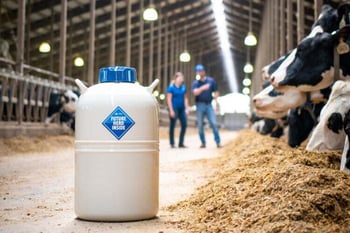Do you have a Beef on Dairy strategy? You’ve chosen to put your breeding strategy in high gear. That means you’re probably using some amount of beef semen as part of that plan.
Creating those black, beef-looking calves can generate a premium on the day-old animals you sell. However, in this process, don’t forget to map out your plan before you start. Have you asked yourself the important questions? The questions that address your farm’s current situation and future goals. The questions about herd inventories and genetics that drive the profitability from your decision to implement beef x dairy.
Don’t let anyone pretend they have all the answers for you on this approach. It’s important not to get swept up in this newest strategy before you’ve set your plan. Start mapping your strategy by considering these three questions and all possible scenarios.
1. Which animals will I breed to beef?
You have a few different methods to separate out which animals will be the mothers of the next generation of your herd versus which animals will be part of your beef on dairy strategy.
First, one of the simplest approaches to segmenting your herd is to sort by lactation group. In this case, you’ll generally designate your second or third lactation animals to receive beef semen, simply because of their older genetics. The remainder of your milking herd and your heifers – because of their newer, and higher genetic levels – would balance out with a combination of sexed and conventional dairy semen.
Next, a cost-effective option for segmenting your herd is to work with your trusted Alta advisor to rank the females in your herd based on your customized genetic plan using 2-generation or 3-generation parent averages. You will breed the top-ranking females on your own index to sexed or conventional semen to create herd replacements. You’ll utilize the lower ranking females as parents for your beef on dairy strategy.
Lastly, you can also use genomic test results to help you segment which animals you should breed to each semen type, but only if the cost of testing falls within your dairy’s operating budget.
 |
 |
2. How much beef semen should I use?
That’s a loaded question – so we encourage you to follow it up with a couple more:
2a. How many cows do I want to milk in three years?
If you see expansion plans in your crystal ball over the next few years, you don’t want to fall short on replacements. Conversely, current market conditions also dictate that it’s not effective to raise more replacements than you need. So if expansion is not in your game plan, improve efficiency by feeding only the animals that will contribute to your future milking herd.
By accounting for dynamics on your farm now, you can develop a fairly accurate plan to manage future inventories – whether your goal is to maintain or grow your herd size in the next three years. Just be sure to consider the factors that affect your inventory, like conception rates by semen type, DOA rates and death loss, cull rates, and more.
2b. What are my options to sell beef x dairy cross calves?
Because the markets can be a roller coaster, we know that prices and premiums on beef x dairy calves can fluctuate. If you don’t have an outlet that offers you an attractive premium (like Alta does) for those black beef x dairy crossbred calves, then you’ll want to evaluate fertility by semen type to see if beef semen is indeed a better strategy than conventional semen.
Whether you segment your herd by genetic rankings or lactation groups, it’s important to monitor and continually adjust the percentage of beef semen you use. Account for any seasonal or management changes so you’re always factoring in the current conception rates, cull rates, and changes in DOA rates or death loss.
3. Which beef bulls should I use?
Our parents or grandparents may have used beef semen as a last resort to get a favorite cow pregnant. We’re willing to bet the straw they used was cheap, clean-up beef semen for that cow’s one last chance.
Today, we can take a more targeted approach to beef x dairy semen selection. Not all beef bulls are created equal… And not all beef breeds are the same. Individual bulls vary greatly, so you’ll get what you pay for in terms of your genetic investment.
As with dairy sire selection, it’s imperative to consider your current situation and future goals. If your lone goal in using beef is simply to create a pregnancy that results in easy calving, then a high fertility beef bull with good calving ease will probably do the trick. Yet, if your calf buyer only offers a premium for the black calves with an actual beef appearance, you will benefit most from considering additional traits like birth weight or ribeye area.
Or are you in a situation where you’re able to raise your beef x dairy cross calves past weaning, or even to harvest? If so, carcass and growth traits should be a key part of your plan, so you can capture the optimal premiums for those animals when you sell.
Regardless of your herd’s breeding strategy, it’s important to map out your own game plan first. Progress and profitability should be a goal now, and in the future. So work with your trusted Alta advisor to determine how best to use beef x dairy in your breeding program. Ask yourself these questions and weigh your options to align your game plan with your current situation and future goals.



